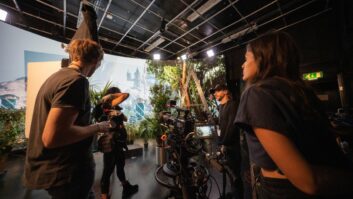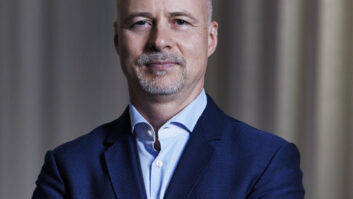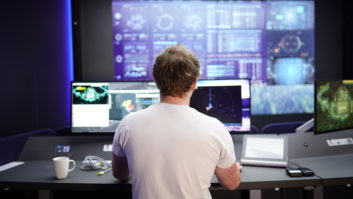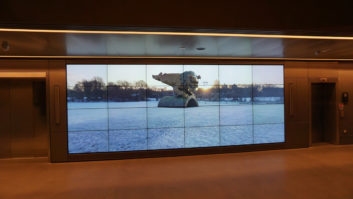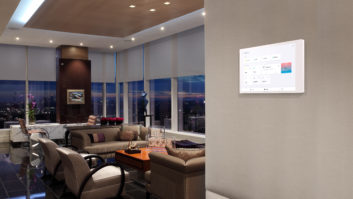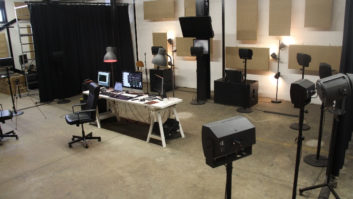IE’s last major survey of show control equipment and associated technology in September 2007 depicted a market segment ever-growing in scope and reach. New applications were continuing to emerge, while the technology supporting them – both hardware and software – was growing in versatility and reliability. The rise of PC-based show control systems, in particular, was helping to generate demand in areas that had previously shown relatively little interest in the technology.
The picture nine months on could be summarised as ‘the same – but even more so’. In a segment of the market where evolution, not revolution, is the order of the day, it follows that manufacturers are continuing to refine and expand their systems – often in response to specific customer requests – while enhancing their suitability for applications that can encompass everything from eye-catching museum centrepieces to elaborate theatrical spectaculars and ‘immersive’ corporate projects.
The division between real-time systems (usually timecoded and ensuring that different things happen at the same time or in an exact sequence) and those that are eventbased (one event triggering another) remains in evidence. However, an increasing number of systems – for example, AV Stumpf l’s Wings Platinum show control software – seek to combine elements of both approaches.
Although Christie’s acquisition of Vista Control Systems last July may be the only recent seismic corporate shift to report, there is undoubtedly a trend towards greater partnership and collaboration as manufacturers look to push the boundaries of a sector that, in the main, appears awash with creative energy – and optimism.
“The control market in general is the biggest source of growth in the AV industry, as the latest survey from InfoComm has shown, and within this show control is becoming more and more important,” observes Benjamin St Girons, EMEA sales manager at Medialon. “Five years or so ago, it was a minor application, but now it is standard practice.”
Evolving technologies
As indicated above, the pattern for many of the leading suppliers tends to be one of ongoing refinement and extra functionality. AV Stumpfl’s Wings Platinum – a timeline-based software package that affords considerable opportunities for interactivity – is a case in point. Functionality added since the software’s original release in 2002 has centred on the ability to bring all elements of a production into one synchronised timeline.
“Everything can be controlled electronically and in one timeline, which makes the production of a show very simple. That is the biggest single improvement in the past four or five years,” says AV Stumpfl’s technical director, Fred Neulinger. “As a result, people just need to learn how to operate one set of software and one system.” Neulinger reveals that new version software (V3.60) is on course to appear around the time of InfoComm later this month.
Configured around a timelinebased effects editor and versatile programming module that enables users to programme and synchronise an unlimited number of devices, Medialon’s Medialon Manager control software has been developed to suit environments as disparate as museums and casinos. It was, however, the increasingly complex requirements of major theme parks that prompted the development of the latest addition to the Medialon platform.
“We have developed an independent scheduler application that is dedicated to the planning and scheduling of all theme park attractions, and to AV resources management. It will be released with Medialon Manager V5 later this month,” reveals St Girons. Medialon has also recently partnered with control giant AMX to develop new, mutually compatible interface solutions. The collaboration has already borne fruit with an AMX plug-in that enables the Medialon Manager software to interface with any AMX NetLinx control system.
PC-based DMX lighting and show control system manufacturer ShowCAD is also prioritising improved interfacing. “We’re continually looking for – and needing – faster and greater signal distribution, and cheaper and more powerful interfaces and data processing,” says the UK-based company’s director, Rowland Hughes.
Hitherto a less ubiquitous name in show control than some of the aforementioned suppliers, video processing/ control technology developer Vista Control Systems has taken a decisive shift upwards in terms of profile since its acquisition by projection giant Christie. “It was a logical move for both companies, and a very good one,” observes Christie’s technical consultant, Nick Wheeler. “Vista Systems was a relatively small although very high-tech company that required greater resources to develop further, while Christie needed something like Vista to widen its product base from projectors to video processing in order to counter some of the other things going on in the market.”
The technological turning point for Vista’s flagship Spyder system, however, predates the acquisition by some time. “The breakthrough for Vista came a few years ago with pixel display,” explains Wheeler. “Until that point, you needed a processing unit per destination per display, meaning that if you had a three-projector blend you needed three processors and a controller. Spyder creates a workspace in real pixels within a single unit that is equal to the projection screen in the number of pixels, enabling very high-resolution processing in real time. It also gives the user total freedom to put anything – any number of sources or types or format of source anywhere on the screen – regardless of where the display device is, be it rear-projection cubes, plasma screens, LED walls or anything.”
E/T/C is another relatively new name in the show control game. The French manufacturer’s Onlyview multimedia control platform is said to be suitable for a variety of live and fixed applications, and enables constant revision and adjustment of extensively pre-planned content. The latest addition – shortly to reach the market – is an integrated 3D engine.
“The new 3D engine allows content to be precisely mapped onto moving three-dimensional objects, as well as to follow the movement of the object onto which it is projected, while continuously being corrected for distortion,” explains E/T/C’s communications and marketing manager, Alison Gill. “In addition, 3D objects as well as entire 3D environments can be imported into a show program, then manipulated independently and directly.” In accordance with the growing versatility of their systems, many suppliers report vigorous business in an increasing number of areas, with higher education, the conference market and ‘immersive’ experiences (for both corporate use and visitor attractions) among the newer contributors. “We are seeing a huge request for live shows, museums, presentations, theatres and opera houses. There is also a particularly strong demand from the university sector,” says Neulinger.
“We see growth in all types of applications,” says Petra Van Meeuwen, marketing manager at control technology company Crestron UK. “For example, we have recently done a complete install for the Jameson Distillery in Ireland, which is a visitor attraction. There is a lot of demand coming from the leisure industry, especially golf and yachting, while meeting rooms and universities seem to be growing steadily as well.”
“Live show control systems are becoming a more important part of the entertainment technology market, from one-off events such as award ceremonies or corporate events, to permanent installations such as museums and theme parks,” observes Gill.
Lighting control
Hughes reports a growing demand for architectural lighting control, but observes that the UK entertainment industry is under considerable pressure. “Everything is becoming more expensive and wages are not rising accordingly, meaning that the public has less disposable income,” he says. “Inevitably, entertainment and leisure are among the first things that people will rein in on. Once an entertainment unit starts to slide, less money is available for upkeep, renovation and improvements, and the knock-on effect is that fewer people will find it appealing, less money wil be taken and businesses will close. This is a very real fact in the leisure industry in 2008.”
By contrast, Netherlands-based integrator Rapenburg Plaza – whose show control projects are based primarily around either the Medialon (for which the company acts as a value-added reseller) or E:Cue (for which it serves as a distributor) systems – reports growing demand from large-scale dance events, but a curious stagnancy in one of its more well-established markets.
“Theatre is not growing in Holland, and I think it has something to do with the fact that there are almost no open-ended productions in the country, as a result of which theatre companies travel around almost like a rock ‘n’ roll tour,” says Rapenburg Plaza’s Rutger van Dijk. “You can open in Amsterdam one day, then two days later you will be setting up in Rotterdam. It’s truck-and-bus touring, and that is why whole-show control system integration is not really used in theatres.”
Traditional applications – from car showrooms to leisure centres – are continuing to fuel Medialon’s growth in Europe and beyond, but some intriguing new possibilities are also looming into view. “We are currently working on a new kind of show for real-estate companies who are setting up a fully immersive environment with projectors that allow clients to preview the real estate they want to invest in,” says St Girons. It is fixed install that is showing the greatest promise for Spyder, although the rental and staging market – the original target for the brand – continues to develop in new ways. “People are going into very wide, very curved screens, and these applications can often require high-end video processing to be able to deliver the goods to the end client,” says Wheeler. “As demand for widescreen applications increases, we are finding that even smaller regional rental and staging companies are looking to invest in this type of technology to be able to satisfy clients. The fact that Vista Spyder is a market leader in that respect, and that the acquisition of Vista has opened up other channel partners and different channels of distribution, is helping to boost the market considerably.”
Further expansion, he suggests, will pivot on the exploration of synergies between the Spyder platform and Christie’s own product range. “A current example would be the Mirage HD projector, which works very well with Spyder,” says Wheeler.
Challenges ahead?
Inevitably, there are some clouds on the horizon. Whereas in the past there were concerns about users possessing the necessary knowledge to operate show control systems effectively, there are now suggestions that a skills shortfall could be inhibiting growth at the supplier end.
“The biggest challenge is finding skilled and fully trained technical people to back up the continued growth in sales,” observes Van Meeuwen. Neulinger echoes the sentiment: “Everybody, including us, is complaining that they cannot get any employees. Growth will be reduced a little bit as a result because we are currently searching for people for production, software development, sales and marketing – in fact, nearly all areas. Five or 10 years ago you could place an advert and be assured of 80 or more applications, but that is just not the case anymore.”
It says something about the health of the show control market, however, that this is the only major concern to be aired during the course of numerous interviews. Indeed, the shared sense of excitement about the continually growing potential of show control technology sometimes borders on the infectious. With corporate clients and theme parks, in particular, seeking to deliver more high-impact installations and attractions, there is now every indication that the suppliers who serve them are ready and able to address any new requirement or challenge.

